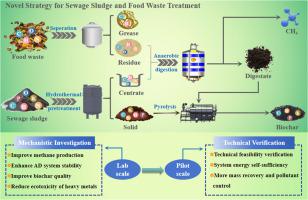当前位置:
X-MOL 学术
›
Water Res.
›
论文详情
Our official English website, www.x-mol.net, welcomes your
feedback! (Note: you will need to create a separate account there.)
Novel strategy for efficient energy recovery and pollutant control from sewage sludge and food waste treatment
Water Research ( IF 11.4 ) Pub Date : 2024-07-05 , DOI: 10.1016/j.watres.2024.122050 Chunxing Li 1 , Ruming Wang 2 , Zengwei Yuan 1 , Shengyu Xie 2 , Yin Wang 2 , Yifeng Zhang 3
Water Research ( IF 11.4 ) Pub Date : 2024-07-05 , DOI: 10.1016/j.watres.2024.122050 Chunxing Li 1 , Ruming Wang 2 , Zengwei Yuan 1 , Shengyu Xie 2 , Yin Wang 2 , Yifeng Zhang 3
Affiliation

|
Considering the high organic matter contents and pollutants in sewage sludge (SS) and food waste (FW), seeking green and effective technology for energy recovery and pollutant control is a big challenge. In this study, we proposed a integrated technology combing SS mass separation by hydrothermal pretreatment, methane production from co-digestion of hydrothermally treated sewage sludge (HSS) centrate and FW, and biochar production from co-pyrolysis of HSS cake and digestate with heavy metal immobilization for synergistic utilization of SS and FW. The results showed that the co-digestion of HSS centrate with FW reduced the NH4 + -N concentration and promoted volatile fatty acids conversion, leading to a more robust anaerobic system for better methane generation. Among the co-pyrolysis of HSS cake and digestate, digestate addition improved biochar quality with heavy metals immobilization and toxicity reduction. Following the lab-scale investigation, the pilot-scale verification was successfully performed (except the co-digestion process). The mass and energy balance revealed that the produced methane could supply the whole energy consumption of the integrated system with 26.2 t biochar generation for treating 300 t SS and 120 t FW. This study presents a new strategy and technology validation for synergistic treatment of SS and FW with resource recovery and pollutants control.
中文翻译:

从污水污泥和餐厨垃圾处理中高效回收能源和控制污染物的新策略
考虑到污水污泥 (SS) 和食物垃圾 (FW) 中的有机物含量和污染物含量高,寻求绿色有效的能源回收和污染物控制技术是一项巨大的挑战。在这项研究中,我们提出了一种综合技术,将水热预处理的 SS 质量分离、水热处理的污水污泥 (HSS) 滤液和 FW 的共消化生产甲烷,以及 HSS 饼和沼渣的共热解生产生物炭与重金属固定化相结合,以实现 SS 和 FW 的协同利用。结果表明,HSS 滤液与 FW 的共消化降低了 NH4+-N 浓度并促进了挥发性脂肪酸的转化,从而产生了更强大的厌氧系统,从而更好地生成甲烷。在 HSS 饼和沼渣的共热解中,沼渣添加提高了生物炭质量,具有重金属固定化和毒性降低。在实验室规模的调查之后,成功进行了中试规模的验证(共消化过程除外)。质量和能量平衡表明,产生的甲烷可以为集成系统的全部能耗提供 26.2 吨生物炭,用于处理 300 吨 SS 和 120 吨 FW。本研究提出了一种协同处理 SS 和 FW 与资源回收和污染物控制的新策略和技术验证。
更新日期:2024-07-05
中文翻译:

从污水污泥和餐厨垃圾处理中高效回收能源和控制污染物的新策略
考虑到污水污泥 (SS) 和食物垃圾 (FW) 中的有机物含量和污染物含量高,寻求绿色有效的能源回收和污染物控制技术是一项巨大的挑战。在这项研究中,我们提出了一种综合技术,将水热预处理的 SS 质量分离、水热处理的污水污泥 (HSS) 滤液和 FW 的共消化生产甲烷,以及 HSS 饼和沼渣的共热解生产生物炭与重金属固定化相结合,以实现 SS 和 FW 的协同利用。结果表明,HSS 滤液与 FW 的共消化降低了 NH4+-N 浓度并促进了挥发性脂肪酸的转化,从而产生了更强大的厌氧系统,从而更好地生成甲烷。在 HSS 饼和沼渣的共热解中,沼渣添加提高了生物炭质量,具有重金属固定化和毒性降低。在实验室规模的调查之后,成功进行了中试规模的验证(共消化过程除外)。质量和能量平衡表明,产生的甲烷可以为集成系统的全部能耗提供 26.2 吨生物炭,用于处理 300 吨 SS 和 120 吨 FW。本研究提出了一种协同处理 SS 和 FW 与资源回收和污染物控制的新策略和技术验证。

































 京公网安备 11010802027423号
京公网安备 11010802027423号